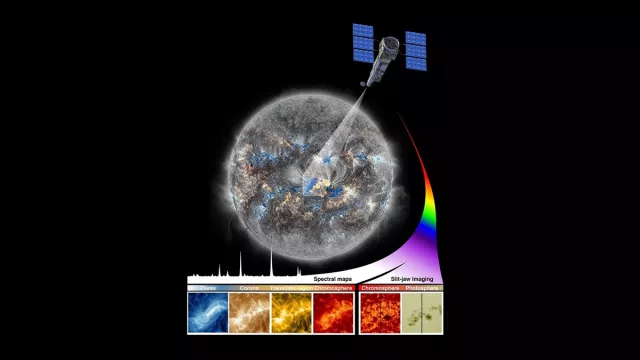An international collaboration led by Japan involving several European nations and the United States, the SOLAR-C mission aims chiefly to gain new insights into the fundamental physical mechanisms driving solar plasma dynamics. To pierce the secrets of this turbulent atmosphere and its winds, flares and “campfires”, the mission will be carrying a single instrument called EUVST (Extreme UltraViolet Spectroscopic Telescope) set to achieve unprecedented spectral, temporal and spatial resolution in the ultraviolet and extreme-ultraviolet portions of the spectrum.
Key information
| Mission | Observe the Sun and its atmosphere |
|---|---|
| Domain | Observation |
| Launch date | Scheduled November 2028 |
| Partners | Japan: JAXA, National Observatory of Japan (NAOJ) USA: NASA, NRL (U.S. Naval Research Laboratory), LMSAL (Lockheed Martin Solar and Astrophysics Laboratory) Germany: MPS (Max Planck Institute for Solar System Research), DLR Italy: INAF (Istituto Nazionale di Astrofisica), ASI United Kingdom: MSSL/UCL (Mullard Space Science Laboratory/ University College London), STFC RAL (Science and Technology Facilities Council /Rutherford Appleton Laboratory) with funding from ESA France: IAS (Institut d'Astrophysique, Orsay), IOGS (Institut d'Optique Graduate School, Saclay), CNES |
| Where | 600-km Sun-synchronous Earth orbit |
| Lifetime | 2 years |
| Status | In development (phase B) |
Key figures
- 0.4 arcseconds spatial resolution
- <1 second temporal resolution
- 2 km/s measurement precision for solar plasma velocity
- 17-280 nm spectral bands (equivalent to plasma temperatures of 5,000 to 15 million Kelvin)
Key milestones
- November 2028: Launch of SOLAR-C
- 2025: Start of phases C and D of EGA development (France)
- 2024: Start of phase B of EGA development
- 2022: Start of phase A of EGA development
- 2018 to 2022: Pre-phase A of development
- 2018: Japan Aerospace Exploration Agency (JAXA) presents mission concept
Project in brief
The SOLAR-C mission aims to understand how the Sun transfers its energy to the rest of the solar system through phenomena like solar flares or the solar wind, which eject huge quantities of particles from its atmosphere in the form of plasma.
To map this atmosphere in unprecedented detail, SOLAR-C will be carrying a single instrument, EUVST (Extreme UltraViolet Spectroscopic Telescope), composed of an extreme ultraviolet (EUV) spectrometer mounted with a 30-cm-diameter telescope. Thanks to its primary mirror and high-performance diffraction grating, EUVST’s optical system is very compact, so it can collect more UV rays than conventional instruments. This unique feature will help it to acquire images with at least ten times better resolution than ever before, reaching a maximum spatial resolution of 0.4 arcseconds and temporal resolution of less than one second.
What’s more, EUVST will also be capable of simultaneous acquisitions at different temperatures, thus covering all of the Sun’s atmosphere from the chromosphere (at about 10,000 Kelvin) to the corona (at several million Kelvin) and even local events like “campfires”.
CNES’s role
- CNES is funding the design, development and fabrication of the EUVST Grating Assembly (EGA) that will split light into separate spectral bands and disperse it to the detectors.
- The IAS space astrophysics institute is supplying the EGA in partnership with the Institut d’Optique Graduate School (IOGS). The EGA is composed of a dual grating array, its adjustment mounting, focusing mechanism and associated control electronics.
Contacts
Project Leader
Eric Lorfèvre
E-mail: eric.lorfevre at cnes.fr
Sun, Heliosphere & Magnetospheres (SHM) subject matter expert
Kader Amsif
E-mail: kader.amsif at cnes.fr


